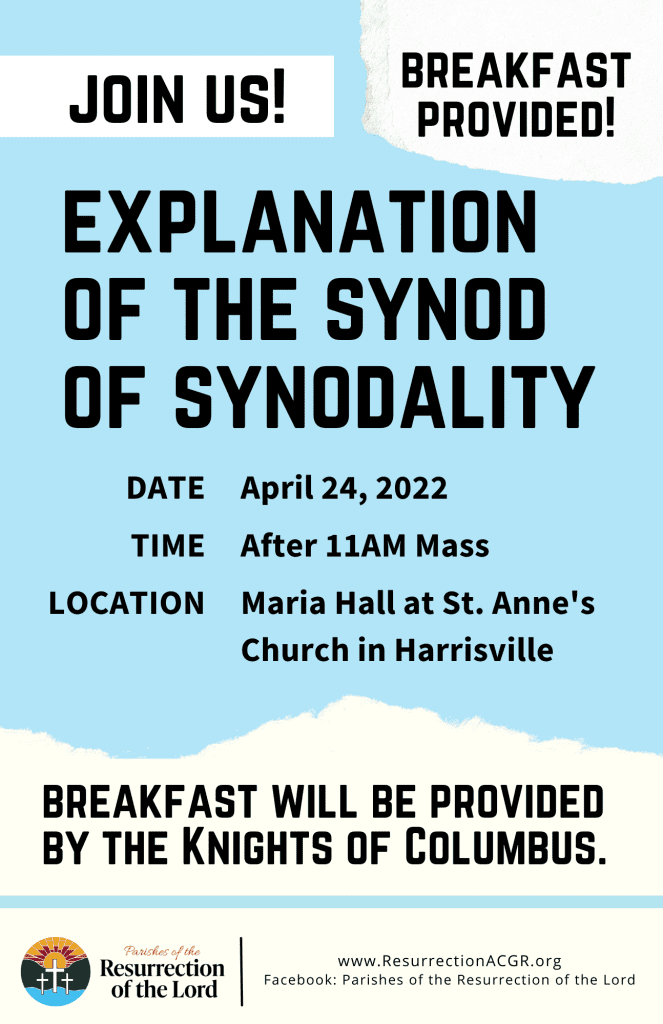April 17, 2022, Easter Sunday, Year C
This Weeks Bulletin:
Click on the link below to view the full page version of the Bulletin.

Join us April 24, 2022 for an Explanation of the Synod of Synodality! Take a moment to watch this video.
From The Priests Desk:
An Easter message from Fr. John William
Easter Sunday of the Resurrection of the Lord, Year C. Opening Prayer:
God our Father,
By raising Christ your Son
You conquered the power of death
and opened for us the way to eternal life.
Let our celebration today
Raise us up and renew our lives
By the Spirit that is within us.
Grant this through our Lord Jesus Christ, your Son,
who lives and reigns with you and the Holy Spirit, God,
forever and ever, Amen.
Catechism Quote of the Week:
The Empty Tomb
CCC 640: “Why do you seek the living among the dead? He is not here, but has risen.” The first element we encounter in the framework of the Easter events is the empty tomb. In itself it is not a direct proof of Resurrection; the absence of Christ’s body from the tomb could be explained otherwise. Nonetheless the empty tomb was still an essential sign for all. Its discovery by the disciples was the first step toward recognizing the very fact of the Resurrection. This was the case, first with the holy women, and then with Peter. The disciple “whom Jesus loved” affirmed that when he entered the empty tomb and discovered “the linen cloths lying there”, “he saw and believed”. This suggests that he realized from the empty tomb’s condition that the absence of Jesus’ body could not have been of human doing and that Jesus had not simply returned to earthly life as had been the case with Lazarus.”
The Appearance of the Risen One
CCC 641: “Mary Magdalene and the holy women who came to finish anointing the body of Jesus, which had been buried in haste because the Sabbath began on the evening of Good Friday, were the first to encounter the Risen One. Thus the women were the first messengers of Christ’s Resurrection for the apostles themselves. They were the next to whom Jesus appears: first Peter, then the Twelve. Peter had been called to strengthen the faith of his brothers, and so sees the Risen One before them; it is on the basis of his testimony that the community exclaims: “The Lord has risen indeed, and has appeared to Simon!”
CCC 642: “Everything that happened during those Paschal days involves each of the apostles – and Peter in particular – in the building of the new era begun on Easter morning. As witnesses of the Risen One, they remain the foundation stones of his Church. the faith of the first community of believers is based on the witness of concrete men known to the Christians and for the most part still living among them. Peter and the Twelve are the primary “witnesses to his Resurrection”, but they are not the only ones – Paul speaks clearly of more than five hundred persons to whom Jesus appeared on a single occasion and also of James and of all the apostles.”
CCC 643: “Given all these testimonies, Christ’s Resurrection cannot be interpreted as something outside the physical order, and it is impossible not to acknowledge it as an historical fact. It is clear from the facts that the disciples’ faith was drastically put to the test by their master’s Passion and death on the cross, which he had foretold. The shock provoked by the Passion was so great that at least some of the disciples did not at once believe in the news of the Resurrection. Far from showing us a community seized by a mystical exaltation, the Gospels present us with disciples demoralized (“looking sad”) and frightened. For they had not believed the holy women returning from the tomb and had regarded their words as an “idle tale”. When Jesus reveals himself to the Eleven on Easter evening, “he upbraided them for their unbelief and hardness of heart, because they had not believed those who saw him after he had risen.”
CCC 644: “Even when faced with the reality of the risen Jesus the disciples are still doubtful, so impossible did the thing seem: they thought they were seeing a ghost. “In their joy they were still disbelieving and still wondering.” Thomas will also experience the test of doubt and St. Matthew relates that during the risen Lord’s last appearance in Galilee “some doubted.” Therefore the hypothesis that the Resurrection was produced by the apostles’ faith (or credulity) will not hold up. On the contrary their faith in the Resurrection was born, under the action of divine grace, from their direct experience of the reality of the risen Jesus.”
Catechism of the Catholic Church, Numbers 640 -644.
